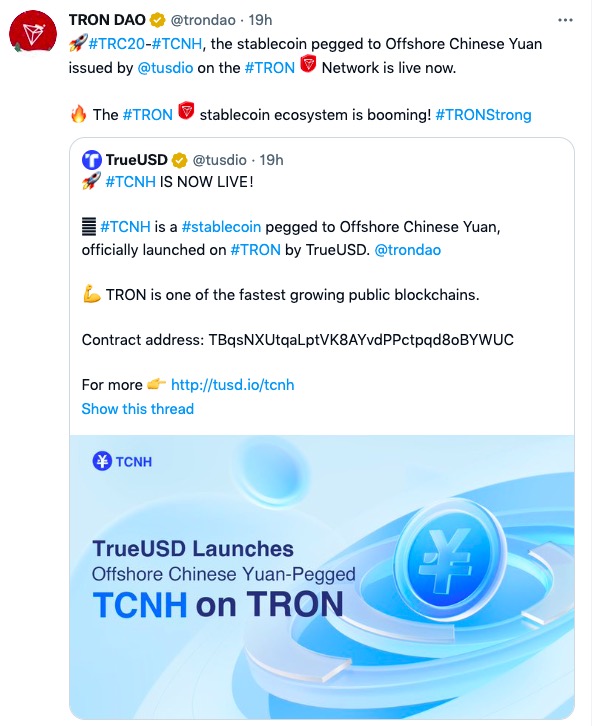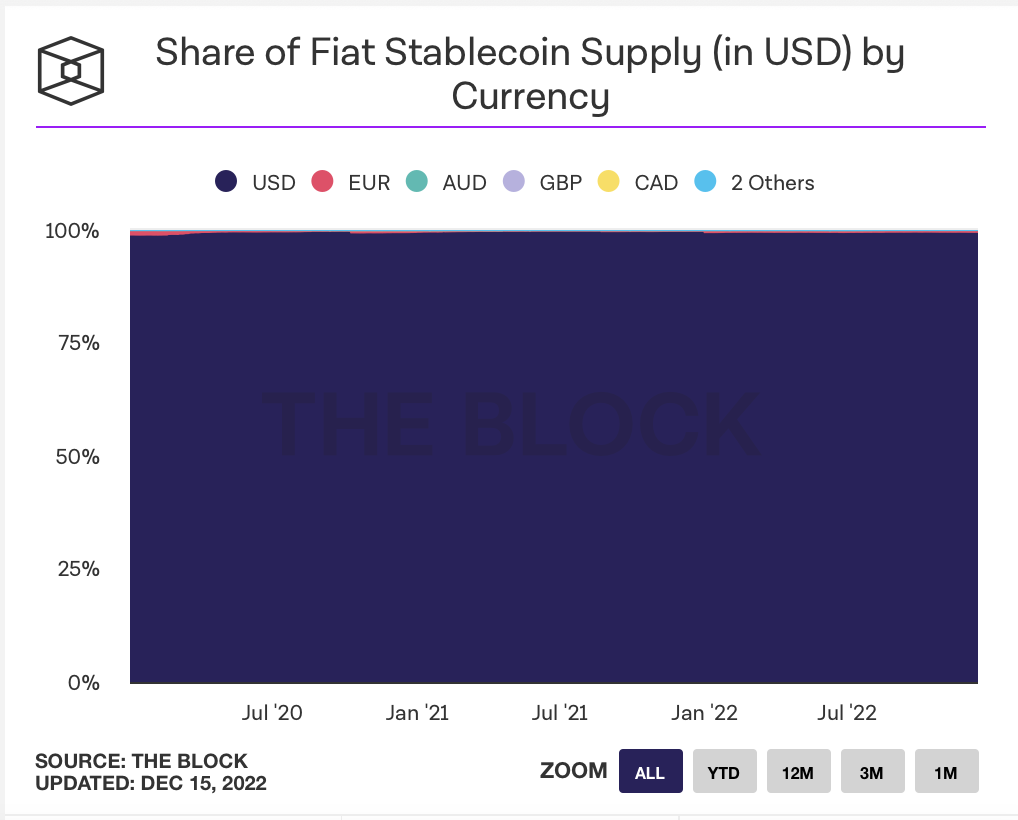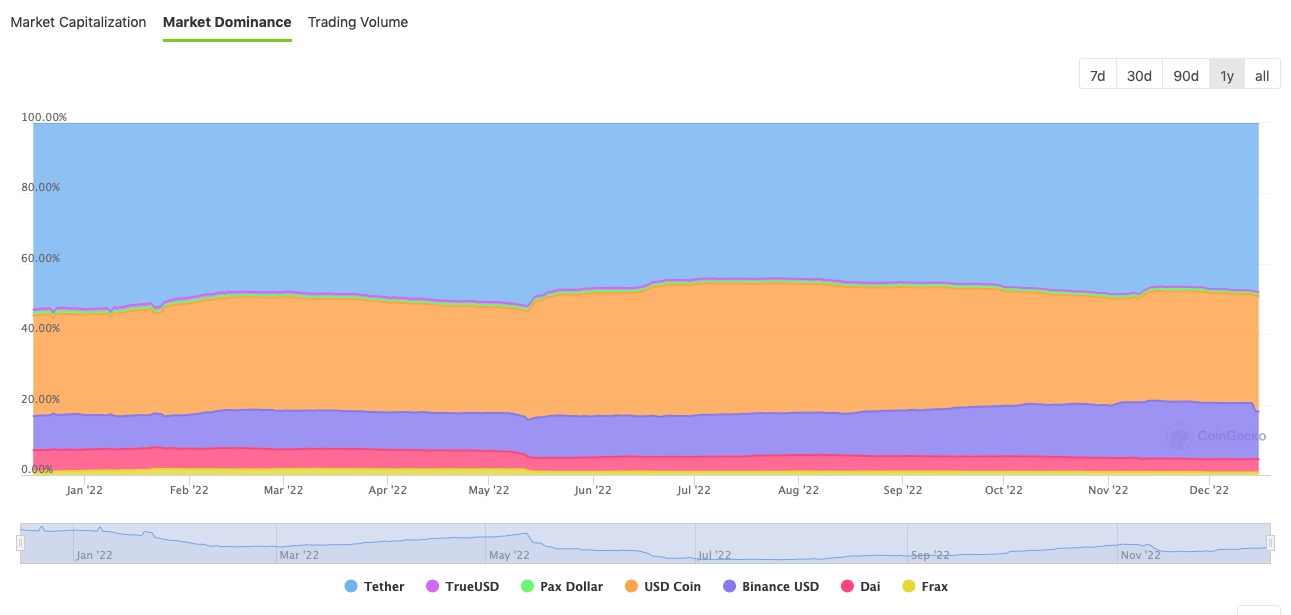Launch of offshore RMB stablecoin TCNH, TrueUSD and TRON's "Quick Breakthrough"
Written by: Nancy, PANews
New developments are emerging in the landscape where the US dollar stablecoin dominates the stablecoin market. Recently, Sun Yuchen, founder of TRON and member of the Huobi Global Advisory Committee, has played a card in the traffic blank zone. The stablecoin TrueUSD announced the launch of the offshore RMB stablecoin TCNH, which is deployed on the TRON blockchain, allowing users to acquire, hold, and trade TCNH on TRON. Sun Yuchen is known for his keen market sense and marketing skills; what surprises will the stablecoin giant and TRON bring this time?

TrueUSD announced the deployment of the offshore RMB stablecoin TCNH on TRON.
Whether in reality or the on-chain world, stablecoins are beginning to play an increasingly important role, and the market scale is rapidly expanding with the diversity of stablecoin projects. Although USDT firmly holds its position due to its first-mover advantage, its market share has significantly declined over the past three years under the onslaught of more transparent and decentralized competitors like USDC, BUSD, Dai, and TUSD.
Compared to the rich application scenarios of US dollar stablecoins, the offshore RMB stablecoin market is relatively blank, which also means that whoever breaks the ice first is likely to capture more potential new traffic.
Hong Kong May Become a Testing Ground for Offshore RMB Stablecoins
Before diving in, let's understand what offshore RMB is. Offshore RMB (CNH) refers to the currency stored and traded outside the issuing country, and is not subject to the financial regulations of the currency issuing country. It typically exists in forms such as foreign exchange reserves or trade settlements, used for global investment and settlement. Unlike onshore RMB (CNY), which is subject to foreign exchange controls and whose exchange rate changes are managed by the central bank, offshore RMB transactions are much freer and unregulated.
TCNH is an offshore stablecoin pegged to the offshore RMB. Looking at the current development of stablecoins, most projects are no longer limited to protecting funds and profits for investors; they are beginning to play an important role in connecting traditional finance and the crypto economy.
The launch of TCNH will bring three positive implications: First, as a new stablecoin, TCNH not only brings new financial opportunities to global users but also offers them more layers and perspectives of financial tools; second, it provides new financial choices for the millions of users on the TRON blockchain, enriching TRON's application ecosystem and trading system; third, it is a further development result promoting the digitization of traditional fiat currencies, which will help strengthen the connection between the crypto world and the real world, addressing the potential needs of the currently turbulent crypto financial market.
In fact, the offshore market is an important platform for currency internationalization, and the launch of offshore RMB stablecoins will facilitate the circulation of offshore RMB overseas and aid in the internationalization of the RMB.
The Bank for International Settlements (BIS) published a quarterly review report stating that due to the expansion of offshore trade, the trading volume of emerging market currencies has grown significantly faster than that of developed market currencies since the mid-2000s. Among the 39 currencies covered in the BIS's three-year survey, the foreign exchange trading volume of RMB (CNY) grew the fastest from April 2019 to April 2022. From the perspective of trading markets, the increase in RMB trading volume largely reflects more active trading between counterparties outside mainland China.
In simple terms, offshore RMB plays a crucial role in the orderly advancement of RMB internationalization. As stablecoins are becoming the "vanguard" of digital dollars, the large-scale development of US dollar stablecoins will further consolidate the dollar's dominant position, which may present opportunities for offshore RMB stablecoins.
Particularly, Hong Kong, as the world's largest offshore RMB market and a global hub for offshore RMB business, is also a testing ground for the vigorous development of virtual assets. Previously, to further leverage the offshore RMB hub function and orderly promote RMB internationalization, the "14th Five-Year Plan" explicitly proposed supporting Hong Kong in enhancing its status as an international financial, shipping, trade center, and international aviation hub, strengthening its functions as a global offshore RMB business hub, international asset management center, and risk management center.
Moreover, Hong Kong recently released a policy declaration regarding the development of virtual assets, stating that given the increasing use of stablecoins, which are said to maintain value stability and serve as mediums of exchange between cryptocurrencies and fiat currencies, they also have the potential to establish connections with traditional financial markets (such as payment systems).
Although the trading volume of CNHT has been sluggish, the expansion of the offshore RMB market and Hong Kong's openness in the virtual asset field may bring more application possibilities and development space for the regulatory-friendly and more transparent TCNH.
It is understood that the Hong Kong Monetary Authority released a discussion paper on "Crypto Assets and Stablecoins" in January 2022, expressing concerns about stablecoins, and relevant policies regarding stablecoins in the Hong Kong Special Administrative Region may be announced soon. Previously, the Monetary Authority also indicated that it might draw on the existing "Payment Systems and Stored Value Facilities Ordinance" in Hong Kong to regulate the issuance of stablecoins and implement a licensing system for stored value payment instruments. If the policy is officially introduced, TCNH could have greater development prospects through the relevant licensing application.
"We see places like Hong Kong moving towards becoming a global digital asset center, and our products are continuously evolving," said Annabel, Director of Market and BD at TrueUSD. "We believe that the launch of TCNH will continue to consolidate our leading position in the construction of digital currency infrastructure and make significant contributions to building a reliable decentralized global financial payment network."
Sun Yuchen, on the other hand, sees something further ahead. He stated on his official Twitter account that both Tether and TrueUSD have chosen to deploy their offshore RMB stablecoins on TRON. CNH₮ and TCNH will accelerate the arrival of the next round of the cryptocurrency bull market. He pointed out that the significance of this event is still not well understood by many.

Filling Market Gaps: TCNH's Differentiated Strategy
As a bridge between traditional finance and the crypto market, stablecoins are one of the important "gears" for the widespread adoption of crypto. Since 2014, the stablecoin market has surpassed $140 billion in scale. Among them, US dollar stablecoins account for an absolute share of over 99%, while the euro, pound, and Canadian dollar share the remaining less than 1% of the market.

As the leading track in the stablecoin market, competition is bound to be fierce, with everyone wanting to become the primary reserve stablecoin in the multi-trillion-dollar crypto economy. From the development of the stablecoin market, although the first-mover USDT still firmly holds the market throne, its market share decline is a fact, and other competitors are catching up.
According to CoinGecko, USDT's current market share is 47.9%, down 9.2% from the beginning of the year; USDC and BUSD's shares are 32.8% and 13.5%, up 15.4% and 40% from the beginning of the year, respectively.
In fact, to seize the stablecoin track, USDC and BUSD have employed various strategies. For instance, USDC issuer Circle will launch a new cross-chain transmission protocol to support USDC interoperability and collaborate with various trading platforms to promote trading scenarios, including fee waivers for conversions with USDT on Coinbase; BUSD, leveraging Binance's strength, has introduced a comprehensive compliance stablecoin automatic exchange feature to provide holders with more DeFi usage scenarios.

Although the scale of the aforementioned stablecoins has expanded, the competition in the stablecoin market still holds uncertainties. For example, USDC has raised market concerns due to its involvement in the US sanctions against Tornado Cash, which froze assets, and the cooling of the DeFi market has hindered further growth for USDC and BUSD.
Compared to the saturated US dollar stablecoin market, the launch of the offshore RMB stablecoin TCNH represents a differentiated strategy.
Before TCNH, Tether had already issued CNH Tether (CNHT) on Ethereum back in 2019, but its usage was not high. Etherscan data shows that CNHT's total supply is 25 million, with only 38 addresses and 736 transactions, which is far from comparable to the trading volume of USDT.
The low trading volume of CNHT may be partly related to the high gas fees on Ethereum. Generally, higher on-chain transaction costs can be a significant expense for ordinary investors. In contrast to Ethereum's shortcomings, TRON offers advantages such as high throughput, fast transfer speeds, and low fees, which is one of the reasons Tether first launched USDT on TRON and then introduced the offshore RMB stablecoin CNHT on the TRON chain on December 6.
TrueUSD, on the other hand, is more compliant and transparent. TUSD is implemented through smart contracts, generating corresponding TUSD upon confirmation of USD deposits, and automatically destroying the corresponding TUSD upon redemption of USD, thus dynamically maintaining a 1:1 peg with the dollar. The dollar assets of TUSD are stored in bank accounts of multiple trust companies that have signed custodial agreements, and the relevant reserve information is updated in real-time on the official website to ensure transparency, in collaboration with top accounting firm Armanino to provide real-time proof of TrueUSD's balance.
Moreover, TUSD also addresses the high barriers to fiat conversion for USDT, as its instant fiat redemption mechanism allows users to convert cryptocurrency to fiat with just a click. TCNH will also continue to adhere to similar legal and technical standards as the TrueUSD series of products and will be audited by world-class auditing firms, aiming to provide global users with more varieties of stablecoin currency options.
Additionally, the competitiveness of USDT, USDC, and BUSD largely depends on trading volume and the strength of the trading platforms behind them. USDT is issued by Tether and Bitfinex, USDC is jointly developed by Circle and Coinbase, and BUSD is issued in collaboration between Binance and Paxos. TrueUSD, supported by Huobi and TRON, has previously launched on platforms such as Binance, Huobi, and Poloniex, and has been deployed on blockchains like Ethereum, TRON, BNB Chain, and Polygon, laying a solid foundation for its trading scale.
In the face of strong competition and the potential for new explosive growth periods, shifting from defense to offense often cannot last long; preparation is needed before the opportunity arises. Reflecting on the "midfield battle" of short videos, compared to Douyin's focus on the small-cap route in first- and second-tier cities, Kuaishou stood out among competitors by leveraging its unique "old iron" culture and down-market positioning to build a solid moat. Now, with TrueUSD and TRON jointly opening up the offshore RMB stablecoin track, this Kuaishou-style offensive may represent a unique breakthrough.










